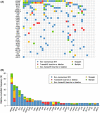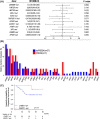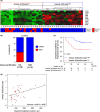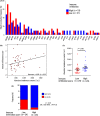Decreased expression of T-cell-associated immune markers predicts poor prognosis in patients with follicular lymphoma
- PMID: 34837284
- PMCID: PMC8819350
- DOI: 10.1111/cas.15224
Decreased expression of T-cell-associated immune markers predicts poor prognosis in patients with follicular lymphoma
Abstract
We previously examined the utility of rituximab-bendamustine (RB) in patients with follicular lymphoma (FL) exhibiting less than optimal responses to 2 cycles of the R-CHOP chemotherapy regimen. The aim of this study was to identify molecular biomarkers that can predict prognosis in RB-treated patients in the context of the prospective cohort. We first analyzed the mutational status of 410 genes in diagnostic tumor specimens by target capture and Sanger sequencing. CREBBP, KMT2D, MEF2B, BCL2, EZH2, and CARD11 were recurrently mutated as reported before, however none was predictive for progression-free survival (PFS) in the RB-treated patients (n = 34). A gene expression analysis by nCounter including 800 genes associated with carcinogenesis and/or the immune response showed that expression levels of CD8+ T-cell markers and half of the genes regulating Th1 and Th2 responses were significantly lower in progression of disease within the 24-mo (POD24) group (n = 8) than in the no POD24 group (n = 31). Collectively, we selected 10 genes (TBX21, CXCR3, CCR4, CD8A, CD8B, GZMM, FLT3LG, CD3E, EOMES, GZMK), and generated an immune infiltration score (IIS) for predicting PFS using principal component analysis, which dichotomized the RB-treated patients into immune IIShigh (n = 19) and IISlow (n = 20) groups. The 3-y PFS rate was significantly lower in the IISlow group than in the IIShigh group (50.0% [95% CI: 27.1-69.2%] vs. 84.2% [95% CI: 58.7-94.6%], P = .0237). Furthermore, the IIS was correlates with absolute lymphocyte counts at diagnosis (r = 0.460, P = .00355). These results suggest that the T-cell-associated immune markers could be useful to predict prognosis in RB-treated FL patients. (UMIN:000 013 795, jRCT:051 180 181).
Keywords: POD24; bendamustine; follicular lymphoma; lymphopenia; tumor microenvironment.
© 2021 The Authors. Cancer Science published by John Wiley & Sons Australia, Ltd on behalf of Japanese Cancer Association.
Conflict of interest statement
IM has received research funding from Chugai and Eizai Pharmaceuticals. SR has received payment for lectures from Chugai Pharmaceuticals. No other potential conflicts of interest were reported.
Figures







References
-
- Carbone A, Roulland S, Gloghini A, et al. Follicular lymphoma. Nat Rev Dis Primers. 2019;5:83. - PubMed
-
- Hiddemann W, Barbui AM, Canales MA, et al. Immunochemotherapy With Obinutuzumab or Rituximab for Previously Untreated Follicular Lymphoma in the GALLIUM Study: Influence of Chemotherapy on Efficacy and Safety. J Clin Oncol. 2018;36:2395‐2404. - PubMed
-
- Marcus R, Seymour JF, Hiddemann W. Obinutuzumab Treatment of Follicular Lymphoma. N Engl J Med. 2017;377:2605‐2606. - PubMed
-
- Federico M, Luminari S, Dondi A, et al. R‐CVP versus R‐CHOP versus R‐FM for the initial treatment of patients with advanced‐stage follicular lymphoma: results of the FOLL05 trial conducted by the Fondazione Italiana Linfomi. J Clin Oncol. 2013;31:1506‐1513. - PubMed
-
- Luminari S, Ferrari A, Manni M, et al. Long‐Term Results of the FOLL05 Trial Comparing R‐CVP Versus R‐CHOP Versus R‐FM for the Initial Treatment of Patients With Advanced‐Stage Symptomatic Follicular Lymphoma. J Clin Oncol. 2018;36:689‐696. - PubMed
MeSH terms
Substances
LinkOut - more resources
Full Text Sources
Research Materials
Miscellaneous

